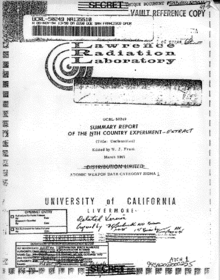
Nth Country Experiment
Encyclopedia

Lawrence Livermore National Laboratory
The Lawrence Livermore National Laboratory , just outside Livermore, California, is a Federally Funded Research and Development Center founded by the University of California in 1952...
starting in May 1964 which sought to assess the risk of nuclear proliferation
Nuclear proliferation
Nuclear proliferation is a term now used to describe the spread of nuclear weapons, fissile material, and weapons-applicable nuclear technology and information, to nations which are not recognized as "Nuclear Weapon States" by the Treaty on the Nonproliferation of Nuclear Weapons, also known as the...
. The experiment consisted in paying three recent young physicists who had just received their PhD
PHD
PHD may refer to:*Ph.D., a doctorate of philosophy*Ph.D. , a 1980s British group*PHD finger, a protein sequence*PHD Mountain Software, an outdoor clothing and equipment company*PhD Docbook renderer, an XML renderer...
s, though had no prior weapons experience, to develop a working nuclear weapon design
Nuclear weapon design
Nuclear weapon designs are physical, chemical, and engineering arrangements that cause the physics package of a nuclear weapon to detonate. There are three basic design types...
using only unclassified information, and with basic computational and technical support. "The goal of the participants should be to design an explosive with a militarily significant yield", the report on the experiment read, "A working context for the experiment might be that the participants have been asked to design a nuclear explosive which, if built in small numbers, would give a small nation a significant effect on their foreign relations."
The experiment ended on April 10, 1967, after only three man-years of work over two and a half calendar years. According to a heavily redacted declassified version of the summary, it was apparently judged by lab weapons experts that the team had come up with a credible design for the technically more challenging implosion style nuclear weapon
Nuclear weapon
A nuclear weapon is an explosive device that derives its destructive force from nuclear reactions, either fission or a combination of fission and fusion. Both reactions release vast quantities of energy from relatively small amounts of matter. The first fission bomb test released the same amount...
. It is likely that they would have been able to design a simpler gun combination weapon even more quickly, though in such a case the limiting factor in developing such a weapon is not usually design difficulty but rather material procurement. The term "Nth Country" referred to the goal in assessing the difficulty in developing basic weapons design (again, not the same thing as the development of weapons themselves) for any potential country with a relatively small amount of technical infrastructure—if the United States was the 1st country to develop nuclear weapons, and the USSR the 2nd, and so on, who would be the Nth country?
Due to the increased amount of publicly available resources regarding nuclear weapons, it is reasonable to assume that a viable weapon design could be reached with even less effort today. However in the history of nuclear weapons
History of nuclear weapons
The history of nuclear weapons chronicles the development of nuclear weapons. Nuclear weapons possess enormous destructive potential derived from nuclear fission or nuclear fusion reactions...
, the development of fission weapons was never strongly hindered by basic design questions except in the very first nuclear weapons programs.
The Summary Report of the Nth Country Experiment was declassified—though heavily excised (somewhat ironically, given its supposed conclusion on the value of secrecy
Secrecy
Secrecy is the practice of hiding information from certain individuals or groups, perhaps while sharing it with other individuals...
)—in 2003.
See also
- United States v. The Progressive, et al. — a court case regarding someone constructing the design for the more difficult hydrogen bomb from public domain documents.
- John Aristotle PhillipsJohn Aristotle Phillips-"A-Bomb Kid":Phillips was born in August 1955 to Greek immigrant parents and raised in North Haven, Connecticut In 1976, while attending Princeton University as a junior undergraduate, he designed a nuclear weapon using publicly-available books and papers...
— a Princeton undergraduate who apparently accomplished a similar feat as those in the Nth Country Experiment in 1977. - Smyth ReportSmyth ReportThe Smyth Report was the common name given to an administrative history written by physicist Henry DeWolf Smyth about the Allied World War II effort to develop the atomic bomb, the Manhattan Project...
— first U.S. release on nuclear weapons technical information (1945) - Nuclear terrorismNuclear terrorismNuclear terrorism denotes the use, or threat of the use, of nuclear weapons or radiological weapons in acts of terrorism, includingattacks against facilities where radioactive materials are present...
External links
- Lawrence Radiation Laboratory, University of California, Livermore, "Summary Report of the NTH Country Experiment," W. J. Frank, ed., March 1967. (copy of original report in PDF format)
- No Experience Necessary Bulletin of the Atomic Scientists, Dan Stober, March/April 2003, pp. 12
- Article from The Guardian

